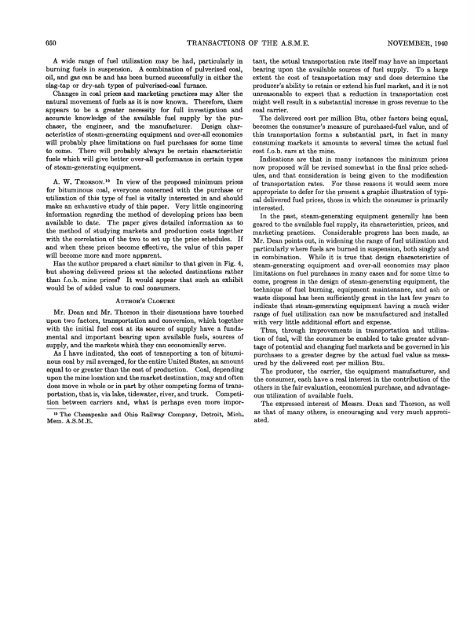Transactions A.S.M.E.
Transactions A.S.M.E.
Transactions A.S.M.E.
Create successful ePaper yourself
Turn your PDF publications into a flip-book with our unique Google optimized e-Paper software.
650 TRANSACTIONS OF THE A.S.M.E. NOVEMBER, 1940<br />
A wide range of fuel utilization may be had, particularly in<br />
burning fuels in suspension. A combination of pulverized coal,<br />
oil, and gas can be and has been burned successfully in either the<br />
slag-tap or dry-ash types of pulverized-coal furnace.<br />
Changes in coal prices and marketing practices may alter the<br />
natural movement of fuels as it is now known. Therefore, there<br />
appears to be a greater necessity for full investigation and<br />
accurate knowledge of the available fuel supply by the purchaser,<br />
the engineer, and the manufacturer. Design characteristics<br />
of steam-generating equipment and over-all economics<br />
will probably place limitations on fuel purchases for some time<br />
to come. There will probably always be certain characteristic<br />
fuels which will give better over-all performance in certain types<br />
of steam-generating equipment.<br />
A. W. T h o r s o n . 10 In view of the proposed minimum prices<br />
for bituminous coal, everyone concerned with the purchase or<br />
utilization of this type of fuel is vitally interested in and should<br />
make an exhaustive study of this paper. Very little engineering<br />
information regarding the method of developing prices has been<br />
available to date. The paper gives detailed information as to<br />
the method of studying markets and production costs together<br />
with the correlation of the two to set up the price schedules. If<br />
and when these prices become effective, the value of this paper<br />
will become more and more apparent.<br />
Has the author prepared a chart similar to that given in Fig. 4,<br />
but showing delivered prices at the selected destinations rather<br />
than f.o.b. mine prices It would appear that such an exhibit<br />
would be of added value to coal consumers.<br />
A u t h o r ’s C l o s u r e<br />
Mr. Dean and Mr. Thorson in their discussions have touched<br />
upon two factors, transportation and conversion, which together<br />
with the initial fuel cost at its source of supply have a fundamental<br />
and important bearing upon available fuels, sources of<br />
supply, and the markets which they can economically serve.<br />
As I have indicated, the cost of transporting a ton of bituminous<br />
coal by rail averaged, for the entire United States, an amount<br />
equal to or greater than the cost of production. Coal, depending<br />
upon the mine location and the market destination, may and often<br />
does move in whole or in part by other competing forms of transportation,<br />
that is, via lake, tidewater, river, and truck. Competition<br />
between carriers and, what is perhaps even more impor<br />
10 The Chesapeake and Ohio Railway Com pany, D etroit, Mich.<br />
Mem. A.S.M .E.<br />
tant, the actual transportation rate itself may have an important<br />
bearing upon the available sources of fuel supply. To a large<br />
extent the cost of transportation may and does determine the<br />
producer’s ability to retain or extend his fuel market, and it is not<br />
unreasonable to expect that a reduction in transportation cost<br />
might well result in a substantial increase in gross revenue to the<br />
coal carrier.<br />
The delivered cost per million Btu, other factors being equal,<br />
becomes the consumer’s measure of purchased-fuel value, and of<br />
this transportation forms a substantial part, in fact in many<br />
consuming markets it amounts to several times the actual fuel<br />
cost f.o.b. cars at the mine.<br />
Indications are that in many instances the minimum prices<br />
now proposed will be revised somewhat in the final price schedules,<br />
and that consideration is being given to the modification<br />
of transportation rates. For these reasons it would seem more<br />
appropriate to defer for the present a graphic illustration of typical<br />
delivered fuel prices, those in which the consumer is primarily<br />
interested.<br />
In the past, steam-generating equipment generally has been<br />
geared to the available fuel supply, its characteristics, prices, and<br />
marketing practices. Considerable progress has been made, as<br />
Mr. Dean points out, in widening the range of fuel utilization and<br />
particularly where fuels are burned in suspension, both singly and<br />
in combination. While it is true that design characteristics of<br />
steam-generating equipment and over-all economics may place<br />
limitations on fuel purchases in many cases and for some time to<br />
come, progress in the design of steam-generating equipment, the<br />
technique of fuel burning, equipment maintenance, and ash or<br />
waste disposal has been sufficiently great in the last few years to<br />
indicate that steam-generating equipment having a much wider<br />
range of fuel utilization can now be manufactured and installed<br />
with very little additional effort and expense.<br />
Thus, through improvements in transportation and utilization<br />
of fuel, will the consumer be enabled to take greater advantage<br />
of potential and changing fuel markets and be governed in his<br />
purchases to a greater degree by the actual fuel value as measured<br />
by the delivered cost per million Btu.<br />
The producer, the carrier, the equipment manufacturer, and<br />
the consumer, each have a real interest in the contribution of the<br />
others in the fair evaluation, economical purchase, and advantageous<br />
utilization of available fuels.<br />
The expressed interest of Messrs. Dean and Thorson, as well<br />
as that of many others, is encouraging and very much appreciated.

















